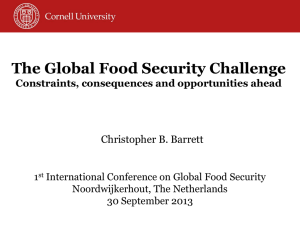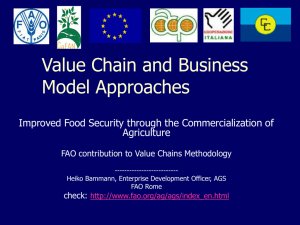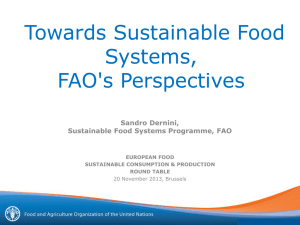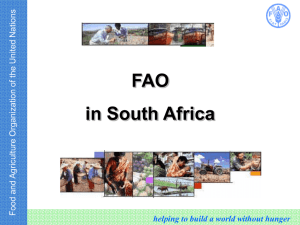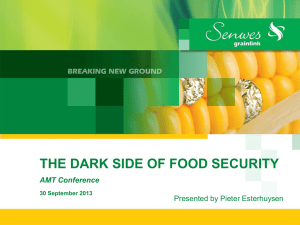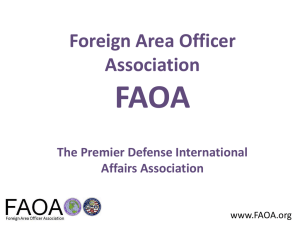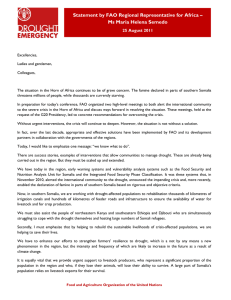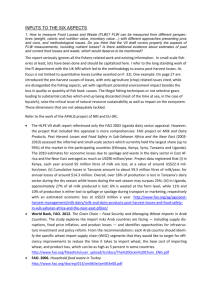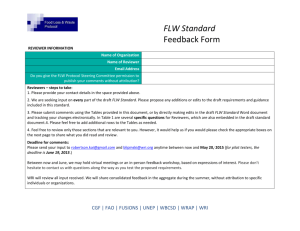Food Loss and Waste Reduction
advertisement
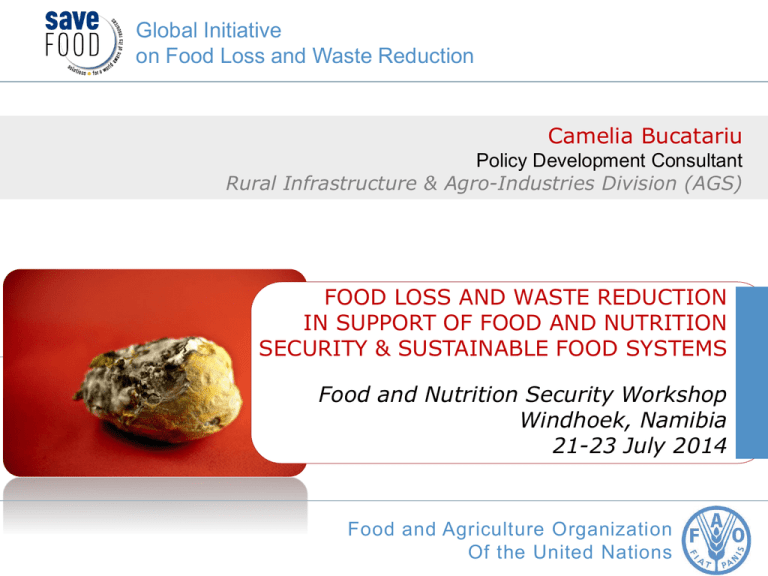
Global Initiative on Food Loss and Waste Reduction Camelia Bucatariu Policy Development Consultant Rural Infrastructure & Agro-Industries Division (AGS) FOOD LOSS AND WASTE REDUCTION IN SUPPORT OF FOOD AND NUTRITION SECURITY & SUSTAINABLE FOOD SYSTEMS Food and Nutrition Security Workshop Windhoek, Namibia 21-23 July 2014 Food and Agriculture Organization Of the United Nations Structure Global setting Zero Hunger Challenge CFS – HLPE Post – 2015 FAO AND SAVE FOOD PARTNERS Terminology Figures & facts Food and nutrition security Corporate and partnership strategy Recovery and re-distribution: food banks, cooked meals, fresh produce Key suggestions Turn the vision of an end to hunger into a reality 2012 Rio+20 Zero Hunger Challenge A vision An invitation to action A means to unite all FAO and UNEP 5th element co-chairs Recognizes interconnectedness of worlds’ food systems and impact on poverty, hunger, malnutrition, natural resources and climate Post-2015 development Agenda – Sustainable Consumption and Production Overview of engagements to date Turn the vision of an end to hunger into a reality 2012 → 2014 Committee on World Food Security (CFS) request to the High Level Panel of Experts on Food Security and Nutrition (HLPE) Report on Food losses and waste in the context of sustainable food systems inform Plenary discussions – October 2014 Food losses and waste in the context of sustainable food systems – July 2014 Causes: consequences of how food systems function → technical, cultural, economic → require an integrated & interrelated perspective → feasible and sustainable solutions → prioritize actions A. micro-level → each stage of the food supply chain, from production to consumption level → result from actions or non-actions of individual actors of the same stage, in response (or not) to external factors B. meso-level → include secondary causes or structural causes → can be found at another stage or result from how different actors are organized; of relationships; or infrastructures etc. → can contribute to the existence of micro-level causes. C. macro-level → malfunctioning food system → lack of institutional or policy conditions to facilitate coordination of actors, adoption of good practices and enable investments → favour all other causes → major reason for global extent Food losses and waste in the context of sustainable food systems – July 2014 Recommendations States & international organizations better integrate food supply chains & systems perspectives in all food security and nutrition strategy or action Reduction of FLW → systematically considered & assessed as potential means to improve agricultural & food systems efficiency and sustainability → improved food security and nutrition Undertake four parallel mutually supportive tracks, in an inclusive and participatory manner: 1. Improve data collection and knowledge sharing on FLW 2. Develop effective strategies to reduce FLW, at the appropriate levels 3. Take effective steps to reduce FLW 4. Improve coordination of policies and strategies in order to reduce FLW FAO efforts towards common terminology Throughout supply chains in industrialized, emerging & DCs Food loss Food loss and waste qualitative & quantitative Food waste Spilled, spoilt, lost (mass) Incurs reduction in quality (e.g. macro- & micronutrients) Unintended result of processes or institutional/ legal framework Discarded (mass) Fit for human consumption (from primary production to fork) Results from negligence or conscious decision 1.3 billion -tonnes ( 1 300 000 000 000 kg ) 1/3 of food produced in the world gets lost or wasted (FAO, 2011) 1 / 3 Quantitative estimations:1.3 billion tons Sub-Saharan Africa net food production (230 mil tons) Grain losses in Sub-Saharan Africa could total $4 billion (source: WB, NRI, FAO, 2011) Industrialized countries consumer level FW (222 mil tons) Industrialized countries > 40% FL at retail and consumer level Developing countries > 40% FL at post-harvest handling and processing Global FLW by commodity Source: FAO. 2011. Global food losses and food waste FLW and carbon footprint Contribution of each commodity to food wastage and carbon footprint 40% 35% 30% % of total 25% 20% 15% 10% 5% 0% Cereals (excluding beer) Starchy roots Commodity 1 Commodity 2 Oilcrops & Pulses Fruits (excluding wine) Commodity 3 Commodity 4 Food wastage Meat Fish & Seafood Milk (excluding butter) & Eggs Vegetables Commodity 5 Commodity 6 Commodity 7 Commodity 8 Carbon footprint Source: FAO. 2013. Food wastage footprint: Impact on natural resources FLW reduction Increased food availability → more efficient than increasing only production Food gets lost when: → Production exceeds demand & supply chain inefficiencies → Large quantities displayed & wide range of brands in supply The Private Sector can reduce FLW at significant scale → invest & act The Public Sector → R&D and guidance → enabling environment Global Initiative on FLW Reduction (SAVE FOOD) Assessment methodology levels causes impacts Evidence-based policies strategies programmes Awareness/capacity development dissemination Global Community of Practice (CoP) Coordination and collaboration in partnerships with public and private sector FAO working group (HQ & Regional Offices) Beneficiaries: the global agricultural and food system stakeholders Primary production Post-harvest handling Processing Distribution By–products and waste management optimization Sales Consumption SAVE FOOD pillar Evidence-based policies, strategies, programmes REGIONAL OFFICES Latin America & The Caribbean Sub-Saharan Africa Asia & The Pacific Eastern Europe & Central Asia North Africa & The Near East LIAISON OFFICES Europe & The EU North America & The World Bank Japan United Nations COUNTRY OFFICES FAO – UNEP Prevention andVersion reduction Guidance 1.0 of food and drink waste in Prevention and and reduction of food businesses households and drink waste in businesses and households Guidance for governments, local authorities, businesses and other organisations Guidance for governments, local authorities, businesses and other organisations FAO – UNEP Guidance Version1.0 FAO – FAO – UNEP Guidance Version1.0 UNEP Guidance Version1.0 Food supply: HO-RE-CA sector, farmers markets, street vendors Industrialized, emerging, and developing countries Drivers: Socio-economic, Environmental, Technological, Regulatory Expression of the drivers through: skills, behavior, motivation, habits FW • Planning • shop list, meals, budget FW • Purchasing • over-buying, portion size (option to choose) vs need, marketing, preferences i.e. shape, colour, date marking FW • Storage at household level • sub-optimal facilities, temperature, packaging, date marking FW • Preparation • sub-optimal use of the resource, portioning FW • Utilization efficiency • leftovers, preferences, skills for food handling, behavior Lack of consumer awareness of quantitative FW Data sources: kerbside waste (garbage, recyclables and green organics), local authorities residual wastes, compositional analysis, kitchen/consumer diaries, Household Waste Recycling Centre (HWRC) Recovery and re-distribution of cooked meals – example from Portugal (European Union) Recovery and re-distribution of cooked meals – example from Portugal (European Union) The Global FoodBanking Network (GFN) The Global FoodBanking Network (GFN) Assess community and country-wide food assistance needs and available resources Recruit business, faith, community, and government leaders to engage with or design the food banking system Develop partnerships with grocery products and other industries to enhance food banking service delivery Provide planning and technical support Share logistical, operational and technology support Promote best practices, expertise, and training resources Assure food bank compliance with food safety standards Egyptian Food Bank Feeding Programs Organize Charitable Work Development Programs Awareness Programs School Feeding Sustainable Monthly Programs School Feeding Educational Programs Seasonal Programs Ramadan Odheya Program Vocational Rehabilitation and Micro enterprises Behavioral Awareness Mega Project Food Wastage Awareness For Hotels and Restaurants Volunteering Programs Families Volunteering EFB Generation Program Corporate volunteering Odheya Program Universities Volunteering EFB is ideal for Relief Programs & was present in times of Accidents and nature Disasters EFB Reached all Egypt Governorates Activity 2006 Monthly Feeding (Dry Food) 10,000 Seasonal Feeding During Ramadan Odheya Meat (families reached) 2010 2011 2012 2013 120,000 150,000 180,000 210,000 50,000 750,550 1,000,000 1,200,000 36,000 1,000,000 1,200,000 1,500,000 Canned Meat with Vegetables 60,000 8,500,000 12,000,000 15,000,000 Volunteers 2,964 45,000 45,000 47,000 1,500,000 1,800,000 20,000,000 47,000 Key messages Coordination, collaboration & partnership for concrete action (public sector, private sector, and civil society) Reduction of FLW increased food availability for sustainable consumption and production food production more efficient than increasing only Workig Groups Session – focused discussion on: 1. How to facilitate a fitting national regulatory framework: strategy, legislation, policy, plans? 2. How to incentivize an efficient system? How to recover and redistribute safe and nutritious surplus from production to consumption? Concrete tools and programmes. 3. How do we organize our dialogue? How to facilitate multi-stakeholder dialogue and hot to integrate the different levels from local to national 4. How to get ready: Criteria for programme implementation on town level? Global Initiative on Food Loss and Waste Reduction Thank you www.fao.org/save-food Join the Initiative and subscibe to the SAVE FOOD Newsletter subsciption Food and Agriculture Organization Of the United Nations
